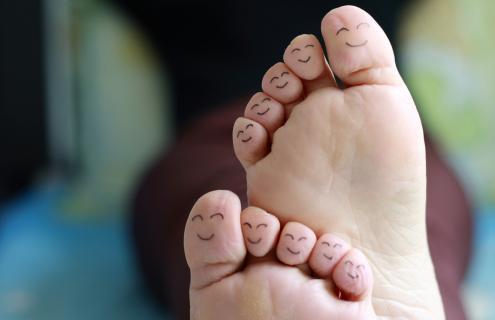
Dr. David M Pinegar came to Cheshire Medical Center from Potsdam, NY, in September 2019. He is board-certified in both foot surgery and reconstructive rearfoot and ankle (RRA) surgery by the American Board of Foot and Ankle Surgery. Eager for the professional opportunities at Cheshire, Dr. Pinegar also sees the Monadnock region as a great place to raise a family. He’s excited to work with Serena R. Shomody, DPM, also a board-certified RRA surgeon, along with Linda Groiss, PA-C, and Paul D. Fachada, DPM in Cheshire’s Podiatry Department.
We spoke with Dr. Pinegar about the essentials of foot care and the highlights of Cheshire’s Podiatry Department.
Q: Why would someone need to see a provider on Cheshire’s Podiatry team?
Dr. Pinegar: A podiatrist is a doctor who specializes in all conditions of the foot and ankle—from the skin to the bone. Some, like Dr. Shomody and I, have extensive training in performing reconstructive surgery on these areas, too. People usually come to see us because they have a sports injury or they have pain in their feet or ankles. We help people by preserving limbs, correcting deformities and treating traumas, in addition to less serious problems.
Q: Why might someone have pain in their feet or ankles?
Dr. Pinegar: A patient might have plantar fasciitis or a high arch causing problems and pain. Or, some people are born with low arches and others have what is called a flexible flat foot deformity.
Wearing high heels or shoes with a narrow toe box can also cause severe pain. High heels are associated with higher incidents of hammertoe deformities, bunion deformities, arthritic degeneration of the joints and ankle sprains. And squeezing your toes into a shoe can cause problems.
Sometimes these conditions require reconstructive surgery, and sometimes we can use nonsurgical treatment — it can depend on how severe the problem is. It is important that patients address foot and ankle problems with their doctor early on, rather than waiting until a condition is serious.
Q: What is your first line of advice for people with foot pain?
Dr. Pinegar: Find shoes that accommodate any kind of condition that you have. Assess the right kind of arch support because flimsy shoes may put stress on different areas of the foot. We can take a look at your feet and determine if your shoes are causing you pain and discomfort.
Sometimes it’s as simple as finding the right inserts and other times we might help you find a shoe or sneaker that can help reduce or eliminate pain. Depending on your condition, sometimes wearing the right shoes or inserts can prevent the problem from becoming worse, or even allow your foot to heal without the need for more serious treatment, like surgery.
Q: What if it’s not your shoe that is causing the pain and discomfort?
Dr. Pinegar: Once we’ve ruled out your shoes, we can evaluate other things. How long you are on your feet? Do you spend a lot of time barefoot? Do you spend a lot of time standing? Is it on a concrete floor? Or are you sitting behind a computer terminal?
Wearing the same shoe around the house as you do when you go for a walk or a hike might be causing pain and discomfort, too.
We also see people who want to improve their health, say, by doing one of those couch-to-5K challenges. While that’s great, if they do it too quickly, it can cause problems with the feet and ankles. By looking at all aspects of a person’s life, we can help them figure out what’s causing the pain and discomfort and find solutions.
Q: Are people with certain pre-existing conditions susceptible to foot problems?
Dr. Pinegar: Oh, yes, especially people with diabetes or conditions that cause neuropathy—the loss of feeling in your feet. If you have neuropathy, you have lost the ability to sense pain, so you could walk with a rock in your shoe or step on an insulin needle and not know it. By the time somebody notices they’ve done some damage, it could be several days or weeks. If the patient goes that long without treatment for that kind of injury, we could be looking at a severe infection that could be limb- or even life-threatening.
Q: What can people with neuropathy do to protect their feet?
Dr. Pinegar: The most important thing is to check your feet, or have someone check them for you, every day. Wearing appropriate shoes and changing your socks every day is also important, and that goes for everyone, whether you have diabetes or not.
Q: What should we be doing to take care of our feet?
Dr. Pinegar: Simple daily practices: changing your socks and washing your feet with soap and water each day, wearing clean, dry shoes, and being careful to trim your toenails appropriately. If you’re not doing it right, you can end up with an ingrown or deformed toenail, which is more likely to get infected with a fungus or bacteria.
Q: Should I be concerned if I keep getting blisters on my feet?
Dr. Pinegar: Yes, we take blisters seriously. Usually, a blister is a problem of friction. Maybe you have bad shoes or a deformity that is putting pressure in a certain area—that is easily fixed with the right shoes. But a blister can also indicate you might have a problem with your veins. If you’re having a problem with blood flow, it can manifest itself as a blister.
Q: When and how should people make an appointment to see a podiatrist?
Dr. Pinegar: Usually folks come to us after getting a referral from their primary care doctor. They’ve been experiencing discomfort and want help. You don’t have to live with pain—we can help you. Feet are so important to enjoying life, and we don’t really realize how important they are until something goes wrong.